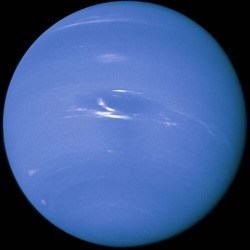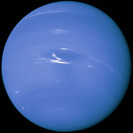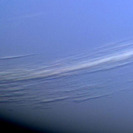Neptune, the farthest planet in our Solar System (sorry, Pluto is not designated as a planet any more), has the longest year of all the planets. One orbit around the Sun takes almost 165 Earth years instead of just one year here on Earth. Like Uranus, Neptune shines so blue due to traces of methane in the topmost layer of its atmosphere. Methane molecules absorb the red part and reflect the blue frequencies of the sunlight. Whilst the surface of neighbouring Uranus is nearly featureless, Neptune has many observable surface features caused by an active weather system. During the Voyager 2 flyby in 1989 the Great Dark Spot - a storm system like the Great Red Spot on Jupiter - was observed. Neptune is the absolute record holder when it comes to storms, and wind speeds can reach up to 2100 km/h (1300 mph), almost reaching supersonic speeds. Under these conditions the ‘moderate' wind speeds of the most extreme tornado measured here on Earth (480 km/h) would feel like a light breeze.
The internal structure of Neptune is a bit different from those of the other gas giants: an atmosphere of gas (mainly hydrogen, helium and methane) overlays a huge ocean of liquid water and ammonia. This ocean makes up most of the mass of the planet. Like the other gas giants Neptune is also believed to have a solid core made of iron, nickel and silicates (rock). The conditions in the centre of Neptune are quite extreme: a pressure of 7 million bar causes temperatures to rise above 5000 K, which is still much lower than the 40 million bar and 36000 K inside the super-massive planet Jupiter.
Like all the other gas giants, Neptune has a ring system, but it's so faint that it hadn't been definitely confirmed before 1989 when Voyager 2 had its flyby.




